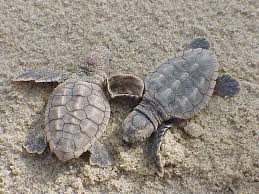Caretta caretta are commonly called “loggerhead” sea turtles due to their overly large heads with a horny beak that is significantly thicker than in other sea turtles. They have a reddish-brown shell, with a pale yellow plastron (underbelly) This species is the largest hard-shelled turtle in the world

Adult males reach about three feet (nearly one meter) in shell length and weigh about 113 kilograms, but large specimens of more than 454 kilograms have been found.
Sea turtles live in almost every ocean of the world.Their enormous range encompasses all but the most frigid waters of the world’s oceans. They seem to prefer coastal habitats, but often frequent inland water bodies and will travel hundreds of miles out to sea. They spend most of their life in saltwater, with females briefly coming ashore to lay eggs. These females will often return, sometimes over thousands of miles, to the beach where they hatched to lay their eggs. Their smooth shells and paddle-like flippers help them speed through the water as fast as 24 kph. These long-distance travellers have been known to swim up to 4.828 km.
They are primarily carnivores, munching jellyfish, conchs, crabs, and even fish, but will eat seaweed and sargassum occasionally.
Their average life span in the wild is more than 50 years. The exact population of this species is unknown but persistent population declines due to pollution, shrimp trawling, and development in their nesting areas, among other factors, have kept this species on the threatened species list since 1978.
Sea turtles cannot withdraw their heads into their shells but the adults are protected from predators by their shells, large size and thick scaly skin on their heads and necks.
Sea turtles spend almost all their lives submerged but must breathe air for the oxygen needed to meet the demands of vigorous activity. Sea turtles can quickly replace the air in their lungs which are adapted to permit a rapid exchange of oxygen and to prevent gasses from being trapped during deep dives. During routine loggerhead sea turtles dive for about 4 to 5 minutes and surface to breathe for 1 to 3 seconds.
